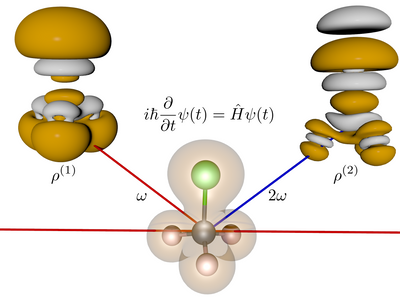Hamiltonian operators, Pauli principle, Born–Oppenheimer approximation, potential energy surfaces, electronic structure theory, wave functions, electron densities, molecular orbitals, Slater determinants, Hartree–Fock, orbital energy and Koopmans’ theorem, group theory and symmetry, spin for many-electron systems, electron correlation, configuration interaction, Møller–Plesset perturbation theory.
CB2070 Molecular Quantum Mechanics 7.5 credits

The course aims to provide fundamental knowledge and introduce selected tools needed to perform quantum mechanical calculations at the molecular level. It addresses students in physics and applied mathematics as well as mathematical- and physical-oriented chemists. It primarily addresses students with a basic understanding of quantum mechanics.
Information per course offering
Choose semester and course offering to see current information and more about the course, such as course syllabus, study period, and application information.
Information for Spring 2025 Start 14 Jan 2025 programme students
- Course location
AlbaNova
- Duration
- 14 Jan 2025 - 16 Mar 2025
- Periods
- P3 (7.5 hp)
- Pace of study
50%
- Application code
60698
- Form of study
Normal Daytime
- Language of instruction
English
- Course memo
- Course memo is not published
- Number of places
Places are not limited
- Target group
- No information inserted
- Planned modular schedule
- [object Object]
- Schedule
- Schedule is not published
Contact
Course syllabus as PDF
Please note: all information from the Course syllabus is available on this page in an accessible format.
Course syllabus CB2070 (Autumn 2021–)Content and learning outcomes
Course contents
Intended learning outcomes
The course aims to provide fundamental knowledge and introduce selected tools needed to perform quantum mechanical calculations at the molecular level. It addresses students in physics and applied mathematics as well as mathematical- and physical-oriented chemists. It primarily addresses students with a basic understanding of quantum mechanics.
After completed course you should be able to:
- form and use wave functions and operators for many-electron systems
- characterise the symmetry of wave functions and thereby understand spectroscopic selection rules
- explain strong covalent bonds in terms of wave functions
- explain the correlated motions of electrons
- perform calculations of approximate wave functions with help of computers
Literature and preparations
Specific prerequisites
Completed course in Quantum Mechanics
Literature
Examination and completion
If the course is discontinued, students may request to be examined during the following two academic years.
Grading scale
Examination
- LAB1 - Laboratory work, 2.5 credits, grading scale: P, F
- TEN1 - Written exam, 5.0 credits, grading scale: A, B, C, D, E, FX, F
Based on recommendation from KTH’s coordinator for disabilities, the examiner will decide how to adapt an examination for students with documented disability.
The examiner may apply another examination format when re-examining individual students.
The examiner, in consultation with the KTH Disability Coordinator (Funka), decides on any adapted examination for students with documented permanent impairment.
In group exercises, all group members share a collective responsibility for the work.
Laboration reports can be complemented
Examiner
Ethical approach
- All members of a group are responsible for the group's work.
- In any assessment, every student shall honestly disclose any help received and sources used.
- In an oral assessment, every student shall be able to present and answer questions about the entire assignment and solution.